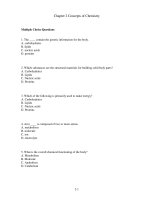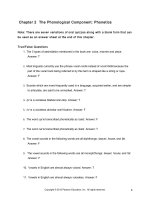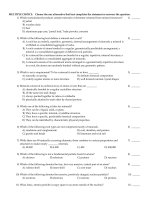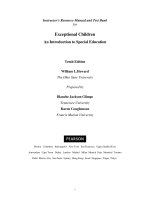Introduction to health care 3rd edition mitchell test bank
Bạn đang xem bản rút gọn của tài liệu. Xem và tải ngay bản đầy đủ của tài liệu tại đây (241.02 KB, 11 trang )
CHAPTER 2—CURRENT HEALTH CARE SYSTEMS AND TRENDS
TRUE/FALSE
1. Throughout much of human history, illness was believed to be caused by forces outside the control of
man.
ANS: T
Only in recent history were causes of and means to effectively treat illnesses discovered.
PTS: 1
2. Anesthesia was not developed until the twentieth century.
ANS: F
Anesthesia was introduced in the nineteenth century.
PTS: 1
3. Until the nineteenth century, medicine and surgery were considered to be very different occupations.
ANS: T
In the nineteenth century, surgery was upgraded from a craft to an experimental science.
PTS: 1
4. The modern hospital typically offers a full range of services for patients needing care until they are
ready to return home.
ANS: F
Hospitals offer acute care, and the patient may need intermediary levels of care before being ready to
return home
PTS: 1
5. The Joint Commission is a government organization that regulates the operation of hospitals.
ANS: F
The Joint Commission is a private, non-profit organization that accredits many types of health care
facilities.
PTS: 1
6. The National Institutes of Health ensure the safety of food and drugs offered to consumers in the
United States.
ANS: F
This function is carried out by the Food and Drug Administration, not the National Institutes of Health.
PTS: 1
7. Many people who are employed do not have access to insurance or affordable health care.
ANS: T
Lack of access to health care is a major problem in the United States.
PTS: 1
8. Preventive care tends to cost less, in the long run, than caring for people who develop serious health
conditions.
ANS: T
Preventive care is generally less expensive than care for serious health conditions.
PTS: 1
9. Many physicians believe they have less control over medical decisions regarding treatment for their
patients than they had in the past.
ANS: T
Many physicians believe they have lost some control over how they treat their patients.
PTS: 1
10. Medicaid is a federal health insurance plan for persons age 65 and older and the disabled.
ANS: F
Medicaid is a federally-funded but state-administered health insurance plan for qualifying low-income
individuals.
PTS: 1
11. Adult foster care provides 24-hour nursing care in a home-like environment.
ANS: F
Adult foster care provides a home-like environment, but does not include 24-hour nursing care.
PTS: 1
12. The United States has one of the lowest rates of infant mortality in the world.
ANS: F
The United States has an infant mortality rate higher than at least forty other countries.
PTS: 1
MULTIPLE CHOICE
1. Discovering the principles of chemistry in the eighteenth century made it possible to:
a. better understand human anatomy.
b. learn how body functions, such as digestion, occur.
c. manufacture disinfectants.
d. develop surgical techniques.
ANS: B
Feedback
A
B
C
D
Discovering the principles of chemistry made progress possible in learning how body
functions, such as digestion, occur.
Correct.
Discovering the principles of chemistry made progress possible in learning how body
functions, such as digestion, occur.
Discovering the principles of chemistry made progress possible in learning how body
functions, such as digestion, occur.
PTS: 1
2. What is the most significant reason for the dramatic increase in expected life span over the last 100
years?
a. Better living habits
b. Improved surgical techniques
c. The development of antibiotics and immunizations
d. A decrease in the number of people living in poverty
ANS: C
Feedback
A
B
C
D
The development of antibiotics and immunizations has had the most significant effect
on life span.
The development of antibiotics and immunizations has had the most significant effect
on life span.
Correct.
The development of antibiotics and immunizations has had the most significant effect
on life span.
PTS: 1
3. Which statement most accurately describes the result of the increased specialization of medicine?
a. It has decreased the cost of medical care.
b. Patients are receiving more consistent care.
c. Relationships between physicians and patients have become closer.
d. Diagnostic and treatment methods have improved.
ANS: D
Feedback
A
B
C
D
Diagnostic and treatment methods have improved with increased specialization of
medicine.
Diagnostic and treatment methods have improved with increased specialization of
medicine.
Diagnostic and treatment methods have improved with increased specialization of
medicine.
Correct.
PTS: 1
4. The growing number of elderly citizens is causing dramatic increases in the need for all of the
following health care services EXCEPT:
a. acute care hospitals.
b. home care services.
c. treatments for chronic illnesses.
d. long-term care facilities.
ANS: A
Feedback
A
B
C
D
Correct.
Home care services have dramatically increased with the growing elderly population.
Treatments for chronic illnesses have dramatically increased with the growing elderly
population.
Long-term care facilities have dramatically increased with the growing elderly
population.
PTS: 1
5. One of the most difficult challenges faced by hospitals today is the need to:
a. continue expanding the number of services offered.
b. control expenses while maintaining an acceptable patient occupancy rate.
c. conduct medical research.
d. find appropriate sites on which to build more hospitals.
ANS: B
Feedback
A
B
C
D
Controlling expenses while maintaining occupancy rates is a difficult challenge for
hospitals today.
Correct.
Controlling expenses while maintaining occupancy rates is a difficult challenge for
hospitals today.
Controlling expenses while maintaining occupancy rates is a difficult challenge for
hospitals today.
PTS: 1
6. The majority of outpatient services are provided by:
a. hospital emergency rooms.
c. urgent care centers.
b. private physicians’ offices.
d. specialty clinics.
ANS: B
Feedback
A
B
C
D
The majority of outpatient services are provided by private physicians’ offices.
Correct.
The majority of outpatient services are provided by private physicians’ offices.
The majority of outpatient services are provided by private physicians’ offices.
PTS: 1
7. Which of the following health care services is expected to provide the largest number of employment
opportunities for today’s health care graduates?
a. Emergency services
c. Hospitals
b. Long-term care
d. Hospices
ANS: B
Feedback
A
B
C
D
The highest growth in employment will be in long-term care.
Correct.
The highest growth in employment will be in long-term care.
The highest growth in employment will be in long-term care.
PTS: 1
8. Which of the following describes one of the primary responsibilities of local health departments?
a. Provide health care services for the poor
b. Conduct research on the causes of disease
c. Inspect and regulate services that affect public health
d. Evaluate the quality of hospital services
ANS: C
Feedback
A
B
C
D
A primary responsibility of local health departments is to inspect and regulate services
that affect public health.
A primary responsibility of local health departments is to inspect and regulate services
that affect public health.
Correct.
They do not evaluate the quality of hospital services.
PTS: 1
9. Encouraging a patient to follow a healthy diet and start an exercise program are examples of the
growing emphasis on the concept of:
a. wellness.
c. expanding consciousness.
b. complementary therapies.
d. progressive health.
ANS: A
Feedback
A
B
C
D
Correct.
Encouraging a patient to follow a healthy diet and exercise plan is based on the concept
of wellness.
Encouraging a patient to follow a healthy diet and exercise plan is based on the concept
of wellness.
Encouraging a patient to follow a healthy diet and exercise plan is based on the concept
of wellness.
PTS: 1
10. Which statement is true regarding the use of complementary medicine in the United States?
a. Practitioners of complementary medicine are always licensed.
b. It has not been proven to have value for patients.
c. It is new, having been developed in the last 25 years.
d. More than one-third of all Americans have tried some form of complementary medicine.
ANS: D
Feedback
A
B
C
D
Not all practitioners of complementary medicine are licensed.
There are complementary therapies that have proven to be of value to patients.
Some forms of complementary medicine have been practiced for thousands of years.
Correct.
PTS: 1
11. What is the major reason why more patients are being encouraged by health care providers to take
responsibility for their own health?
a. Links have been discovered between lifestyle habits and major diseases.
b. This reduces the number of malpractice lawsuits.
c. Providing health care is too costly.
d. Patients are more satisfied when given responsibility for their own health.
ANS: A
Feedback
A
B
C
D
Correct.
There is a strong link between lifestyle habits and major diseases.
There is a strong link between lifestyle habits and major diseases.
There is a strong link between lifestyle habits and major diseases.
PTS: 1
12. Which of the following best describes palliative care?
a. Promote movement and function
c. Provide comfort and pain control
b. Give specialized treatment
d. Treat chronic conditions
ANS: C
Feedback
A
B
C
D
Rehabilitation therapies promote movement and function. Palliative care provides
comfort and pain control.
Specialized treatments have the goal of curing a disease or injury. Palliative care
provides comfort and pain control.
Correct.
Chronic conditions are treated with the goal of curing or improving. Palliative care
provides comfort and pain control.
PTS: 1
13. The current life expectancy for females born in the United States in 2005 is:
a. 70 years.
c. 90 years.
b. 80 years.
d. 100 years.
ANS: B
Feedback
A
B
C
D
The current life expectancy for females born in the United States in 2005 is 80 years.
Correct.
The current life expectancy for females born in the United States in 2005 is 80 years.
The current life expectancy for females born in the United States in 2005 is 80 years.
PTS: 1
14. Which of the following claims is a sign that a health care product or service may be fraudulent?
a. It can be provided only by certain individuals.
b. The practitioner promises confidentiality regarding your treatment records.
c. It is extremely expensive.
d. It claims to cure a wide variety of unrelated health problems.
ANS: D
Feedback
A
B
C
D
Many legitimate health care treatments can be provided only by certain, qualified
individuals.
All health care practitioners must keep medical records confidential.
Many legitimate health care products and services are very expensive.
Correct.
PTS: 1
MATCHING
Match each person with the correct contribution below.
a. Elizabeth Blackwell
e. Edward Jenner
b. Sigmund Freud
f. Anton van Leeuwenhoek
c. William Harvey
g. Joseph Lister
d. Hippocrates
h. Louis Pasteur
1.
2.
3.
4.
5.
6.
7.
8.
Discovered principle of smallpox vaccination
Proposed that blood circulates throughout the body
Invented the microscope
Proved that certain microorganisms cause disease
Was the first female physician in the United States
Is considered to be the father of medicine
Developed surgical techniques to prevent the entry of microorganisms into wounds
Did pioneering research on the causes of psychological illnesses
1.
2.
3.
4.
5.
6.
7.
8.
ANS:
ANS:
ANS:
ANS:
ANS:
ANS:
ANS:
ANS:
E
C
F
H
A
D
G
B
PTS:
PTS:
PTS:
PTS:
PTS:
PTS:
PTS:
PTS:
1
1
1
1
1
1
1
1
Match each health care unit or facility with the correct service provided below.
a. Assisted living residence
g. Intensive care unit
b. Cardiac care unit
h. Intermediate care facility
c. Continuing care community
i. Transitional care unit
d. Emergency room
j. Psychiatric hospital
e. General unit
k. Rehabilitation unit or hospital
f. Hospice
l. Skilled nursing facility
9. Specialized care and equipment for patients with very serious illnesses and injuries
10. Therapies to regain physical and mental function
11. Variety of living arrangements that range from independent living to the provision of regular medical
and nursing care
12. Housing, meals, and help with personal care
13. Care for seriously ill patients who do not need constant nursing care
14. Specialized care and equipment for patients with serious heart conditions
15. 24-hour nursing services for patients who need long-term care
16. Care and support for dying patients
17. Care and rehabilitation for patients with mental and behavioral disorders
18. Care and assessment to determine long-term needs
19. Personal care, social services, and nursing care as needed
20. Immediate care for serious illnesses and injuries
9.
10.
11.
12.
13.
14.
15.
16.
17.
18.
19.
20.
ANS:
ANS:
ANS:
ANS:
ANS:
ANS:
ANS:
ANS:
ANS:
ANS:
ANS:
ANS:
G
K
C
A
E
B
L
F
J
I
H
D
PTS:
PTS:
PTS:
PTS:
PTS:
PTS:
PTS:
PTS:
PTS:
PTS:
PTS:
PTS:
1
1
1
1
1
1
1
1
1
1
1
1
Match the following types of therapy with the correct explanation below.
a. Acupuncture
e. Massage therapy
b. Chiropractic
f. Osteopathy
c. Holistic medicine
g. Reflexology
d. Homeopathy
h. Therapeutic touch
21.
22.
23.
24.
25.
26.
27.
28.
All aspects of the individual must be considered when planning treatments.
The body can protect itself if the musculoskeletal system is in good order.
Bodily dysfunction is caused by pressure on nerves as they leave the spinal column.
Disorders can be cured with very small doses of substances that cause the symptoms of the disorder.
Pressure on the muscles promotes blood circulation and healing.
Tiny needles are inserted along the body’s energy pathways.
Pressure points on the feet are manipulated.
The hands are used just above the surface of the body to direct energy flow.
21.
22.
23.
24.
25.
26.
27.
28.
ANS:
ANS:
ANS:
ANS:
ANS:
ANS:
ANS:
ANS:
C
F
B
D
E
A
G
H
PTS:
PTS:
PTS:
PTS:
PTS:
PTS:
PTS:
PTS:
1
1
1
1
1
1
1
1
COMPLETION
1. The government agency responsible for controlling the spread of diseases is known as the
________________________________________.
ANS:
Centers for Disease Control and Prevention
Center for Disease Control and Prevention
CDC
PTS: 1
2. A promising medical development is _______________, which involves inserting normal DNA into
cells to correct a genetic defect or to treat a disease.
ANS: gene therapy
PTS: 1
3. Using pharmaceutical products to block the growth of cancer cells is called
_________________________.
ANS: targeted drug therapy
PTS: 1
4. There is an increasing use of ____________________, in which conventional medical treatments are
combined with scientifically-tested complementary treatments.
ANS:
integrative medicine
integrated medicine
PTS: 1
5. _________________________ is a serious public health problem in which many drugs are no longer
effective in killing disease-causing bacteria.
ANS: antibiotic resistance
PTS: 1
6. The principal purpose of the ______________________________ , supported by the federal
government, is to conduct medical research.
ANS: National Institutes of Health
PTS: 1
7. __________ provides care, comfort, and support to dying individuals and their families.
ANS: hospice
PTS: 1
8. _______________ is a complementary medicine treatment in which patients inhale the scents of
essential oils.
ANS: aromatherapy
PTS: 1
9. A currently used definition of __________ is the promotion of health and practice of good lifestyle
habits.
ANS: wellness
PTS: 1
10. The 2009 outbreak of influenza caused by the H1N1 virus raised concerns about the possibility of a
worldwide __________.
ANS: pandemic
PTS: 1
SHORT ANSWER
1. List five health care issues that are being addressed in the twenty-first century.
ANS:
Vaccine to prevent HIV; cures for AIDS, obesity, heart disease, hypertension, cancer; more effective
treatments for mental illnesses; cloning of organs for transplantation; expanded use of
alternative/complementary therapies by traditional Western practitioners; longer life span; less
invasive treatments; treatments with fewer side effects
PTS: 5
2. What are five factors that have contributed to the rising cost of providing health care in the United
States?
ANS:
Technological advances, increased number of elderly citizens, rising costs of pharmaceutical products,
increasing number of diagnostic and treatment options, overuse of diagnostic tests, lack of
competition, rising expectations of patients, increasing requests for medical care, malpractice suits,
malpractice insurance, insurance companies and providers seeking profits
PTS: 5
3. List five ambulatory health care facilities and briefly describe the services they offer.
ANS:
Adult day care: activities, meals, and supervision for adults unable to function on their own
Dental offices: prevention, diagnosis, and treatment of problems with the teeth
Diagnostic centers: procedures to determine causes of diseases and injuries
Emergency and urgent care: care for conditions that need immediate attention
Onsite services in non-health-care places such as companies, prisons, and schools: basic and
preventive care
Laboratories: collecting samples, conducting tests, making teeth, prosthetics, and eyeglasses
Rehabilitation centers: providing therapy to regain function, overcome special problems
Specialty clinics: large variety that include treatment for specific diseases, help with certain disorders,
provision of counseling, etc.
Surgical centers: surgery that doesn’t require hospitalization
Wellness centers: physical exams, immunizations, education programs
PTS: 5
4. What are three ways that health care professionals can help meet the challenges facing today's health
care system?
ANS:
Keep informed, perform duties to the best of their ability, model good health habits, provide patient
education
PTS: 5
ESSAY
1. Discuss the expansion of home health services. Include the reasons for the increase in home care, the
types of services provided, and which health care occupations make home visits.
ANS:
Reasons – shorter hospital stays, more chronic diseases, increasing number of elderly citizens,
advances in equipment allowing more procedures to be done in the home
Services – nursing; physical, occupational, and speech therapy; social workers; personal care;
housekeeping tasks, shopping, transportation
Occupations – nurses, therapists and therapy assistants, certified nursing assistants, and home health
aides
PTS: 10
2. Discuss the meaning of the following statement and its implications for health care workers: “We
cannot expect to be rescued from every disease and cause of death by the nation’s health care system if
we do not take responsibility for our own health.”
ANS:
We need to follow wellness and healthy living practices that we know prevent illness and injury.
High cost of health care, along with limitations of science, cannot cure every illness.
People must accept some responsibility for their own health by adapting good lifestyle habits (diet,
exercise, stress management, not smoking, and so on), getting immunizations, seeking information
about wellness.
(Answers will vary. Students may have many additional suggestions.)
PTS: 10









